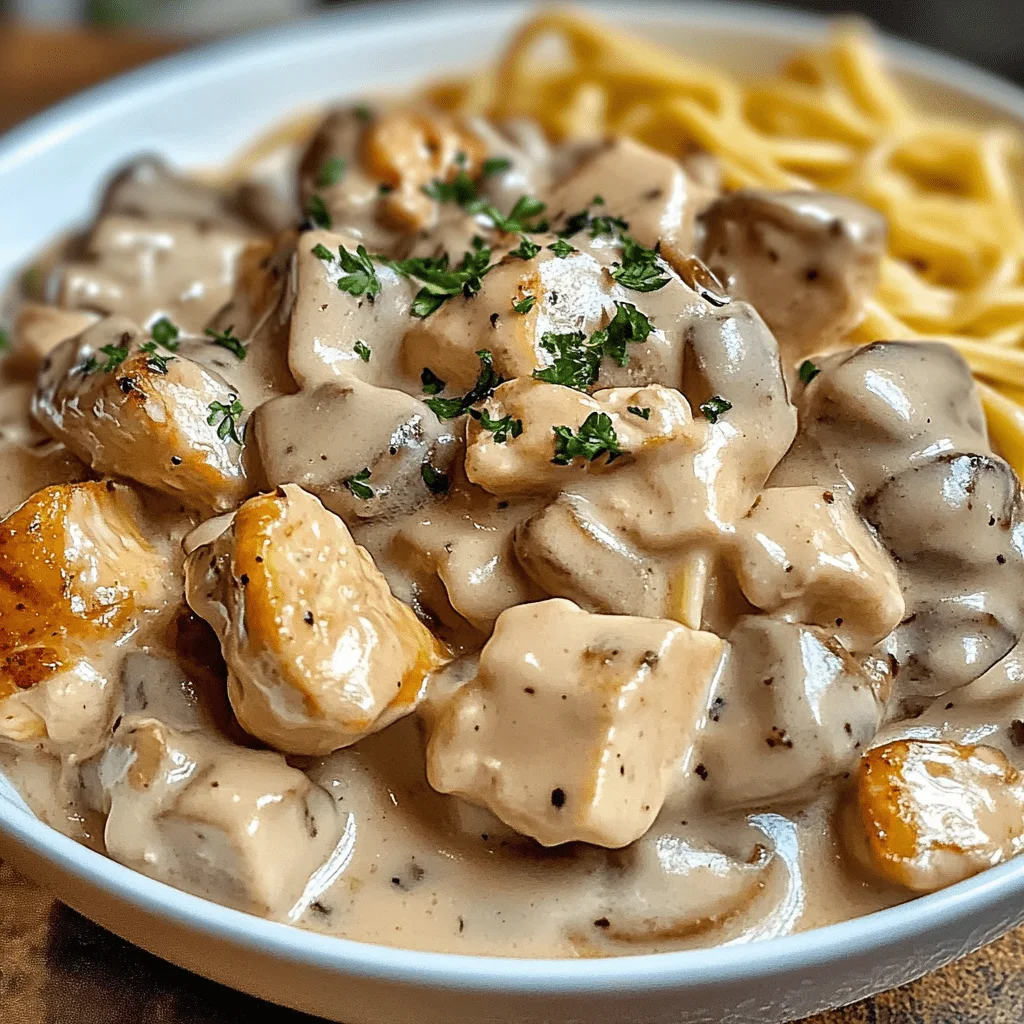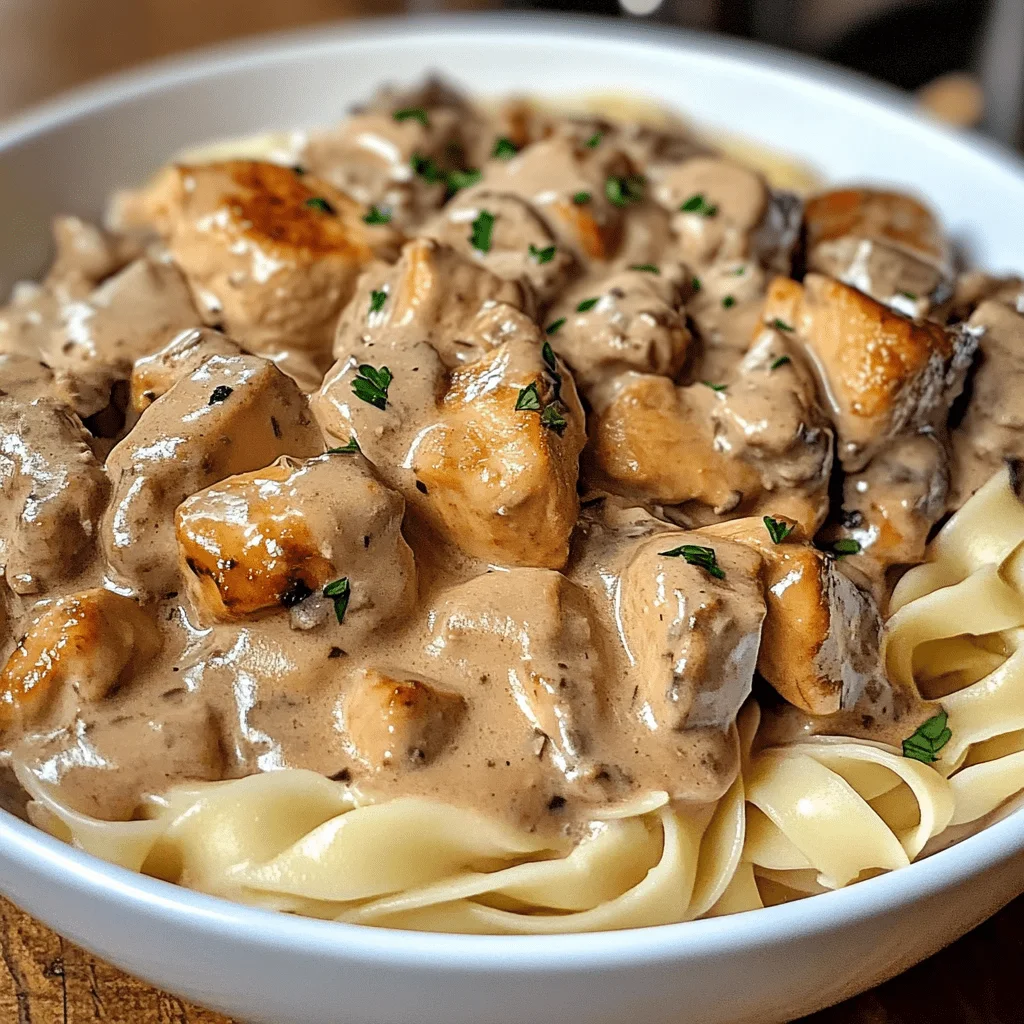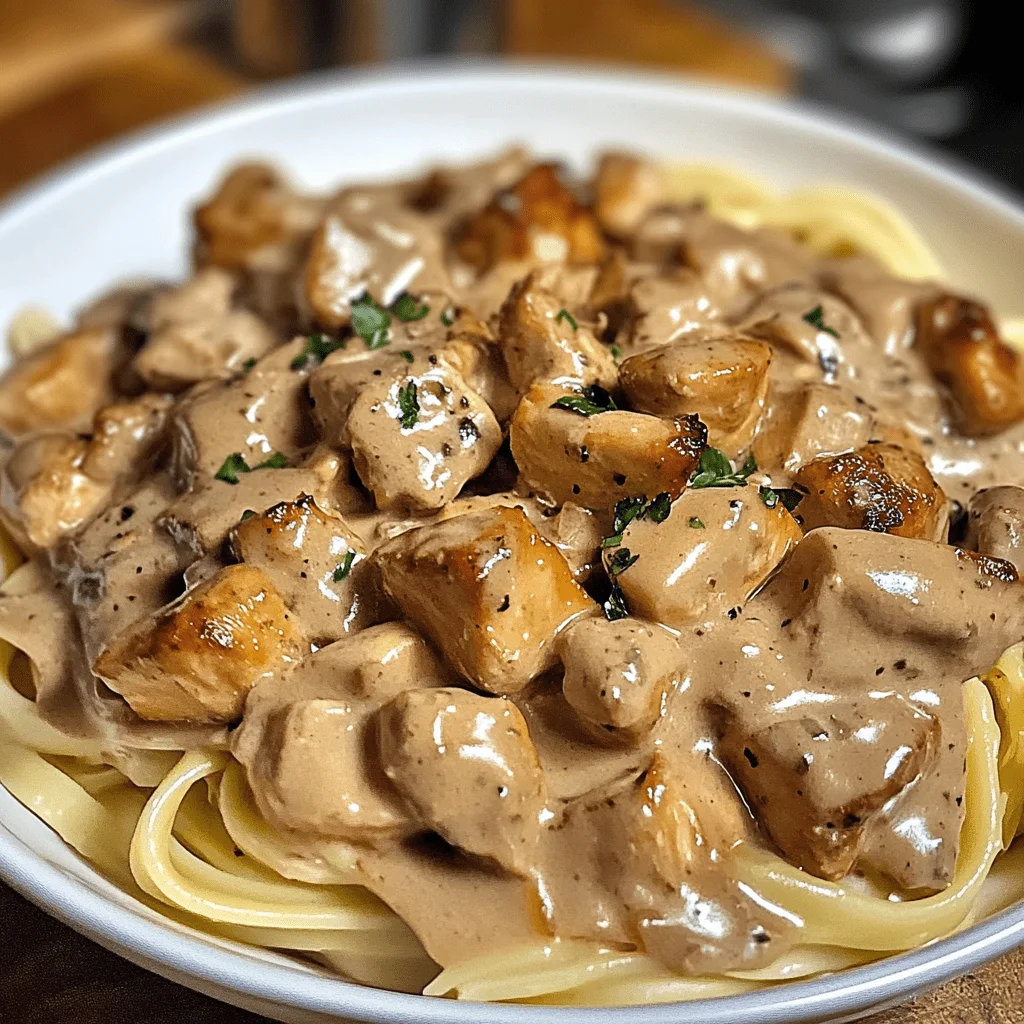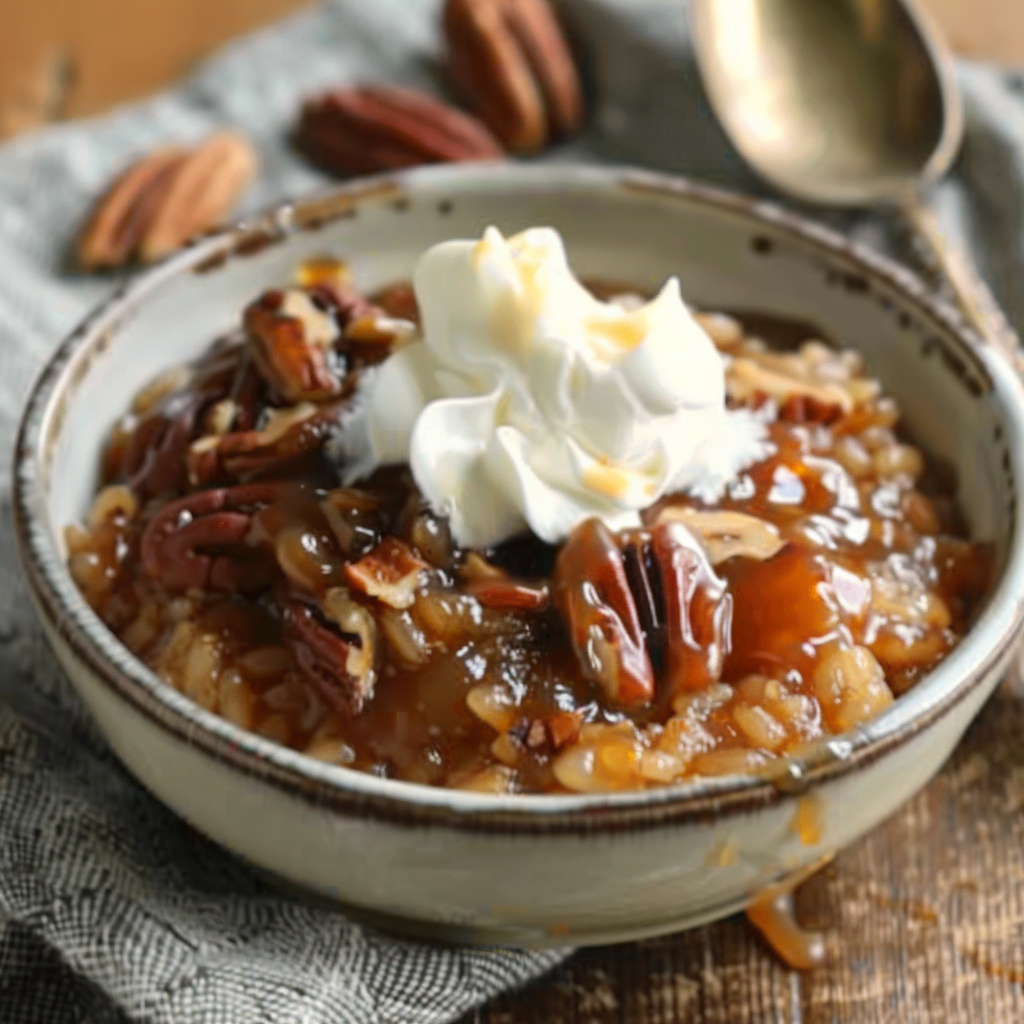Simple ingredients transform into a restaurant-worthy chicken stroganoff in just 20 minutes. This dish stands out as the quickest way to create comforting food at home. The classic recipes might seem daunting, but this version needs just a few ingredients and basic techniques.
Our extensive testing has refined this chicken stroganoff recipe to perfection. We chose chicken thighs for their juiciness and created a creamy sauce’s perfect balance with sour cream and mustard. The dish delivers 23 grams of protein per serving and remains a true comfort food classic when served over traditional egg noodles, rice, or mashed potatoes.
Let me show you how to create the perfect chicken stroganoff in this piece. You’ll discover the right ingredients and become skilled at getting the sauce consistency just right. The techniques that matter most will be clear, and you’ll learn to avoid common mistakes that could affect your dish’s outcome.
Choosing the Right Ingredients for Chicken Stroganoff
Your chicken stroganoff’s success comes down to picking the right ingredients. The qualities each ingredient brings to this classic dish will help you create a version that tastes rich and balanced.
Best chicken cuts: thighs vs. breasts
The choice between chicken thighs and breasts isn’t just about what you like – it affects your final dish. Chicken thighs are generally superior and with good reason too. They stay juicy and tender while you cook them. You won’t ruin them if you cook them a bit too long, and they pack way more flavor than breasts.
Chicken breasts can turn out great too. One expert puts it this way: “While chicken thighs stay juicier, properly seared chicken breast can be just as good”. Breasts need more attention since they dry out easily. The upside? They cook faster, so they’re perfect for quick weeknight dinners.
These basic techniques work great for both cuts:
- Cut the meat into even, bite-sized pieces
- Season well before cooking
- Give the chicken a quick sear to keep the juices in
Mushroom types that add the most flavor
The mushrooms you pick can really change your stroganoff’s taste. Cremini mushrooms (baby bella) make the best choice for this dish. They bring an earthy, umami-rich flavor that makes the sauce more interesting than regular white button mushrooms.
You’ve got several great options:
- Cremini/baby bella: Rich, earthy flavor and meaty texture
- White button: Milder flavor but perfectly acceptable
- Shiitake: Intense, smoky quality for mushroom lovers
- Mixed varieties: For complex, layered mushroom flavor
The way you cook mushrooms matters just as much as the type you choose. Great mushroom flavor needs three steps: moisture release, liquid evaporation, and browning. This takes about 10-15 minutes in a wide skillet, and the amazing flavor makes it worth the wait.
Why sour cream and mustard matter
Sour cream and mustard aren’t just extras – they’re essential defining ingredients that make stroganoff what it is. Sour cream gives you that classic tangy taste and silky texture that sets stroganoff apart from other creamy sauces. You don’t need much – half a cup for four servings hits the sweet spot.
Dijon mustard is a vital flavor booster. It adds depth and balances the cream’s richness with subtle heat and tang. Mustard and sour cream together create that classic stroganoff taste – tangy, creamy, and complex all at once.
Here’s a pro tip: add sour cream after taking the pan off the heat. This stops it from curdling. Boiling can make sour cream separate, leaving you with grainy sauce instead of something smooth and velvety.
Greek yogurt works as a substitute for sour cream, but it might curdle more easily because it has less fat. Some chefs like to mix half sour cream and half heavy cream if the tang seems too strong.
Amazing chicken stroganoff needs more than just throwing ingredients together. The tang from sour cream, depth from mustard, and rich flavors from well-browned mushrooms create a perfect blend that makes this dish unforgettable.

Prepping for Success: What to Do Before Cooking
Good preparation makes the difference between an average chicken stroganoff and an amazing one. A few simple steps before cooking will raise your dish from good to unforgettable.
How to cut and season the chicken
Pick your chicken pieces based on what you like. Boneless, skinless chicken thighs give you richer flavor, while chicken breasts work great as a leaner option. Whatever you choose, proper cutting technique is vital.
Start by patting the chicken dry with paper towels. This might seem like a small detail, but it’s absolutely needed to get that perfect brown crust. Moisture is the enemy of caramelization – skip this step and you’ll end up with steamed meat instead of nicely seared pieces.
Cut your chicken into even 1-2 inch cubes. Same-sized pieces will cook evenly, so you won’t have some pieces overcooked while others stay raw. If you have thick chicken breasts, slice them horizontally first to get more uniform pieces.
Here’s a balanced seasoning mix I recommend:
- Kosher salt and black pepper
- Garlic powder
- Paprika (adds nice color and warmth)
Mix these spices in a small bowl before adding them to make sure they spread evenly on all the chicken pieces. Don’t be shy with seasoning – the meat should taste great even before you add the sauce.
The importance of dredging in flour
Dredging chicken in flour isn’t just tradition – it changes everything about your chicken stroganoff. This simple step serves many purposes in creating an exceptional dish.
Dredging creates a light coating that helps brown the meat evenly and keeps the chicken juicy during searing. The flour-coated bits will help thicken your stroganoff sauce to just the right consistency.
Here’s what to do: put flour in a shallow dish, add salt and pepper, then coat each piece of chicken and shake off extra. Some cooks season the chicken before dredging, while others mix seasonings into the flour – both ways work great.
People who can’t eat gluten can use cornstarch instead. Just mix 1 tablespoon cornstarch with 1 tablespoon water to replace the flour coating. This swap keeps the sauce thick while making your stroganoff gluten-free.
Setting up your cooking station
A well-organized kitchen reduces stress while making chicken stroganoff. Setting up your cooking station beforehand saves time and helps avoid mistakes during cooking.
Your workspace should have these zones:
- Cutting and seasoning area (cutting board, knife, paper towels, seasoning mix)
- Dredging station (shallow dish with seasoned flour)
- Cooking zone (large skillet, oil, and cooking tools)
- Holding area (foil-covered bowl for cooked chicken)
Get your skillet hot over medium-high heat before adding oil. Cook in batches instead of crowding the pan – this lets each piece brown nicely rather than steam. You’ll need to add more oil between batches since the pan gets dry.
Keep that skillet unwashed after cooking the chicken! Those stuck-on brown bits (fond) at the bottom pack tons of flavor that will make your sauce amazing. You’ll scrape these up later when adding liquids for your stroganoff sauce.
Last but important – measure and prep all ingredients before you start cooking. Once you begin, especially with mushrooms and sauce-making, timing becomes key. Ready ingredients let you focus on technique instead of rushing to measure things mid-cook.
Step-by-Step: How to Make Chicken Stroganoff
The chicken stroganoff recipe involves three vital phases that enhance flavor throughout the cooking process. These techniques will help you create a restaurant-quality dish with tender chicken and a silky, rich sauce.
Searing the chicken for maximum flavor
A perfectly seared chicken creates the foundation of an exceptional stroganoff. Heat oil in a large skillet over medium-high heat until it’s almost smoking. The seasoned, flour-dredged chicken pieces should be added without overcrowding the pan. Press down lightly with a spatula to maximize contact with the pan surface.
Chicken thighs need about 4 minutes on the first side until golden, then 2 minutes after flipping. Breast pieces require approximately 3 minutes per side. The chicken doesn’t need to cook completely since it will finish in the sauce later.
The pan’s temperature might need adjustment between batches if it gets too hot or starts smoking. Note that color equals flavor on both the chicken and in the pan. The browned bits (fond) will become your sauce’s base.
Building the sauce with mushrooms and onions
Once you’ve moved the chicken to a plate, melt butter in the same skillet. Start with onions and cook them until they begin to soften – about a minute. The sliced mushrooms go in next.
Patience is essential here. Mushrooms release much moisture at the time, which must evaporate before they brown properly. This takes 6-8 minutes, so don’t rush. The mushrooms should turn a beautiful golden brown.
Your spatula should be used to scrape up the browned bits from the pan’s bottom. This step infuses the chicken’s flavor into your mushrooms and onions, creating a depth that makes homemade stroganoff stand out.
Incorporating broth, mustard, and sour cream
The sauce transforms into a proper stroganoff next. Dijon mustard, Worcestershire sauce, and minced garlic should be stirred in for about a minute to enhance their flavors. The chicken broth goes in while you continue stirring and scraping up any remaining fond.
The chicken and its juices return to the pan. Everything simmers for 2-3 minutes to thicken the sauce and finish cooking the chicken.
The most significant technical step comes next: heat reduction before adding sour cream prevents curdling that would ruin the sauce’s texture. Gentle stirring incorporates the sour cream fully. The sauce might look split initially, but continued gentle heating creates a smooth, velvety texture as the sour cream blends into the sauce.
A final gentle simmer for another minute, or until the sauce reaches heavy cream consistency, completes your chicken stroganoff.

Common Mistakes and How to Avoid Them
Making chicken stroganoff can challenge you even if you’re an experienced cook. Let’s look at these common issues and learn exactly how to fix them. This will help you make perfect stroganoff every time.
How to prevent curdling the sour cream
Your smooth sauce can turn into an unappetizing, grainy mess – this is the biggest problem in chicken stroganoff preparation. The sour cream’s proteins break apart from water and clump together under high heat.
You should always temper your sour cream before adding it to the hot mixture to prevent curdling. Mix a small amount of warm sauce slowly into the sour cream to raise its temperature gently. The pan should be on low heat or off the stove completely before you add sour cream.
You need full-fat sour cream – lower-fat versions (under 25% fat) will definitely curdle. A bit of heavy cream added before the sour cream gives extra protection against curdling.
The sauce starts curdling? Reduce heat right away and whisk vigorously. You can rescue a separated sauce by whisking in 1-2 tablespoons of butter at low temperature in extreme cases.
Avoiding bland sauce: seasoning tips
Bland stroganoff usually happens because you haven’t developed flavor foundations properly. The fond—those golden-brown bits left after searing the chicken—creates amazing flavor.
Use broth or wine to deglaze and dissolve this fond into your sauce. A touch of Worcestershire sauce adds remarkable depth without overpowering other flavors.
Dijon mustard is vital for authentic stroganoff flavor. It works perfectly with the creamy elements and adds subtle complexity.
What to do if your sauce is too thin or thick
Your sauce is too thin? Try these fixes:
- Create a slurry with 1-2 tablespoons cornstarch and equal parts cold water, then stir it into the simmering sauce
- Let it simmer longer for natural reduction
- Add some starchy pasta water if you’re using pasta – it helps thicken the sauce
The sauce becomes too thick? Add small amounts of broth gradually until you reach the right consistency. Taste as you go since thinning can dilute flavors – you might need more seasoning.
You can use flour as another thickener, especially early in cooking—either dredge the chicken or make a roux with butter. Cornstarch works better than arrowroot powder for gluten-free options since arrowroot doesn’t mix well with dairy-based sauces.
Serving and Storing Your Stroganoff
A great chicken stroganoff needs the right side dishes and proper storage methods. These final touches will raise your dining experience and help you enjoy this classic dish for multiple meals.
Best sides to serve with chicken stroganoff
Chicken stroganoff pairs naturally with wide egg noodles that catch the creamy sauce in their ridges. Your options go way beyond the reach and influence of this classic choice. Mashed potatoes make a comforting alternative that absorbs every bit of the rich sauce. You could also try:
- Rice options: White rice or rice pilaf complement the dish perfectly
- Bread accompaniments: Crusty bread adds excellent texture contrast and helps soak up remaining sauce
- Low-carb alternatives: Cauliflower rice, cauliflower mash, or zucchini noodles keep the experience intact for carb-conscious diners
The rich creaminess needs balance with vegetables. Simple steamed broccoli or sautéed green beans create textural contrast. Fresh garden salads or roasted vegetables work great too.
How to store and reheat leftovers
Your chicken stroganoff stays fresh in the refrigerator for 3-4 days in airtight containers. The sauce’s texture stays better when stored separately from noodles or other starches.
Two reheating methods give excellent results:
Stovetop method: Warm gently over medium-low heat and stir occasionally to prevent scorching. The sauce might need a splash of chicken broth or water if it thickens during storage. This method gives you better control and texture.
Microwave method: Heat in 30-second bursts and stir between each interval. This stops the cream from separating due to overheating.
Can you freeze chicken stroganoff?
Cream-based sauces make freezing chicken stroganoff tricky. Regular versions with sour cream might separate after thawing, which affects texture. Notwithstanding that, you can freeze it using these methods:
Fully prepared stroganoff stays good in airtight containers for up to 2-3 months. The texture changes somewhat after thawing, but remains safe to eat.
The best results come from freezing the chicken and sauce before adding dairy components. Just:
- Cook everything except adding sour cream
- Cool completely in the refrigerator
- Freeze in sealed containers for up to three months
- Thaw overnight in refrigerator
- Reheat gently, then add fresh sour cream
Good serving, storage, and reheating techniques help you enjoy your chicken stroganoff for several meals.

FAQs
Q1. What are the key ingredients for a delicious chicken stroganoff? The main ingredients for chicken stroganoff include chicken (preferably thighs), mushrooms, onions, garlic, sour cream, chicken broth, and Dijon mustard. Additional flavorings like Worcestershire sauce and paprika can enhance the taste. The dish is typically served over egg noodles or rice.
Q2. How can I prevent the sour cream from curdling in my stroganoff? To prevent curdling, always temper the sour cream before adding it to the hot mixture. Take a small amount of the warm sauce and slowly mix it into the sour cream to gently raise its temperature. Additionally, reduce the heat to low or remove the pan from heat before incorporating the sour cream.
Q3. What’s the best way to add flavor to my chicken stroganoff? To enhance flavor, start by properly searing the chicken to create a flavorful fond. Use mushrooms like cremini for a rich, earthy taste. Incorporate Worcestershire sauce and Dijon mustard for depth and tanginess. Don’t forget to season well with salt, pepper, and consider adding paprika or fresh herbs like thyme for extra complexity.
Q4. Can chicken stroganoff be frozen for later use? While it’s possible to freeze chicken stroganoff, it’s best to freeze the chicken and sauce before adding dairy components. When ready to eat, thaw overnight in the refrigerator, gently reheat, and then add fresh sour cream. This method helps maintain the best texture and flavor when reheating.
Q5. What are some alternatives to serve with chicken stroganoff besides egg noodles? While egg noodles are traditional, there are many delicious alternatives. Consider serving your stroganoff over mashed potatoes, rice, or crusty bread. For low-carb options, try cauliflower rice, cauliflower mash, or zucchini noodles. Pairing with steamed vegetables or a fresh salad can also balance the rich, creamy sauce.
Print
How to Make Perfect Chicken Stroganoff: A Foolproof Recipe Guide
Description
Enjoy Easy Chicken Stroganoff with Mushrooms and a velvety sour cream sauce. It’s the perfect recipe for cozy nights or meal prep.
Ingredients
2 chicken breasts cut into 1-inch pieces
1/2 teaspoon garlic powder
Salt and pepper to taste
All-purpose flour for dredging
3 tablespoons olive oil divided
1 tablespoon butter
8 ounces cremini baby bella mushrooms, sliced
1/2 medium onion chopped
1–2 tablespoons Dijon mustard to taste
1–2 tablespoons Worcestershire sauce to taste
3 cloves garlic minced
2/3 cup chicken broth
1/2 cup full-fat sour cream
Instructions
Cut the chicken into 1-inch pieces and season with garlic powder, salt and pepper. Dredge in flour, shaking off excess.
Heat 2 tablespoons olive oil in a large skillet over medium-high heat. Cook the chicken in two batches until browned and cooked through, about 3 minutes per side. Transfer to a plate.
Add the remaining 1 tablespoon olive oil and butter to the skillet. Add the mushrooms and onions. Sauté for 6-8 minutes until browned and any liquid has evaporated.
Stir in the Dijon, Worcestershire, and garlic. Cook for 1 minute.
Pour in the chicken broth and scrape up any browned bits. Return the chicken to the skillet and cook for 2 minutes.
Remove from heat and stir in the sour cream until combined. Season with salt and pepper.
Serve immediately over egg noodles, mashed potatoes or rice.
Notes
For maximum flavor, brown the chicken, mushrooms and onions well.
Add a pat of butter with the sour cream for extra richness.
Stir in spinach or peas for added nutrition and color.
Garnish with crispy fried shallots for a fun crunch.









